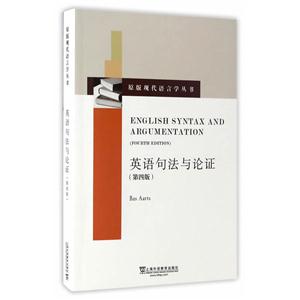扫一扫
关注中图网
官方微博
本类五星书更多>
-
>
鲍勃·迪伦诗歌集:1961-2012:典藏版
-
>
双城记-英文版
-
>
四级词汇词根+联想记忆法:乱序版
-
>
The secret garden
-
>
哈克贝利.费恩历险记/床头灯英语.2000词读物(英汉对照)
-
>
10000德语分类词汇联想记忆
-
>
英语词汇全书
英语句法与论证 第四版 版权信息
- ISBN:9787544645188
- 条形码:9787544645188 ; 978-7-5446-4518-8
- 装帧:一般胶版纸
- 册数:暂无
- 重量:暂无
- 所属分类:>
英语句法与论证 第四版 本书特色
由巴斯·阿尔茨所*的《英语句法与论证(第4版 )(英文版)》是“原版现代语言学系列”丛书中的一 本。本书全面介绍了英语句法中的基本概念,并由浅 入深地分析英语词汇、短语、连贯、辩论等各种句法 学要点。第四版专门增加一章介绍如何分析英语的时 体态势。本书供相关研究人员参考。
英语句法与论证 第四版 内容简介
由巴斯·阿尔茨所著的《英语句法与论证(第4版)(英文版)》是“原版现代语言学系列”丛书中的一本。本书全面介绍了英语句法中的基本概念,并由浅入深地分析英语词汇、短语、连贯、辩论等各种句法学要点。第四版专门增加一章介绍如何分析英语的时体态势。本书供相关研究人员参考。
英语句法与论证 第四版 目录
Preface to the First Edition
Preface to the Second Edition
Preface to the Third Edition
Preface to the Fourth Edition
Part I Function and FormIntroductionKey ConceptsFunction2.1 Subject and Predicate2.2 Predicator2.3 Direct object2.4 Indirect object2.5 AdjunctKey ConceptsExercisesFurther ReadingForm: Words, Word Classes and Phrases3.1 The notion 'word'3.2 Nouns and determinatives3.3 Adjectives3.4 Verbs3.5 Prepositions3.6 Adverbs3.7 Conjunctions3.8 InterjectionsKey ConceptsExercisesFurther ReadingMore on Form: Clauses and Sentences4.1 Clauses and clause hierarchies4.2 The rank scale4.3 Clause types4.3.1 Declarative clauses4.3.2 Interrogative clauses4.3.3 Imperative clauses4.3.4 Exclamative clauses4.3.5 The pragmatics of the clause types4.4 More on tree diagramsKey ConceptsExercisesFurther ReadingThe Function-Form Interface5.1 Function-form relationships5.2 Realisations of the Subject5.3 Realisation of the Predicate and Predicator5.4 Realisations of the Direct object5.5 Realisations of the Indirect object5.6 Realisations of AdjunctsKey ConceptsExercisesFurther Reading
Part II Elaboration6 Predicates, Arguments and Thematic Roles6.1 Predicates and arguments6.2 Thematic roles6.3 Grammatical functions and thematic roles6.4 Selectional restrictions6.5 Three levels of descriptionKey ConceptsExercisesFurther Reading7 Cross-Categorial Generalisations: X-Bar Syntax7.1 Heads, Complements and Specifiers7.2 Adjuncts7.3 Cross-categorial generalisations7.4 Subcategorisation7.4.1 Subcategorisation versus argument/thematic structureKey ConceptsExercisesFurther Reading8 More on Clauses8.1 The I-node8.2 Subordinate clauses8.2.1 Clauses functioning as Direct object, Subject and Adjunct8.2.2 Clauses functioning as Complements within phrases8.2.3 Clauses functioning as Adjuncts within NPsKey ConceptsExercisesFurther ReadingMovement9.1 Verb Movement: aspectual auxiliaries9.2 NP-Movement: passive9.3 NP-Movement: Subject-to-Subject Raising9.4 Movement in interrogative sentences: Subject-Auxiliary Inversion9.5 Wh-Movement9.6 The structure of sentences containing one or more auxiliariesKey ConceptsExercisesFurther Reading10 Tense, Aspect and Mood10.1 Time and tense10.1.1 The present tense10.1.1.1 Uses of the present tense10.1.2 The past tense10.1.2.1 Uses of the past tense10.1.3 Ways of referring to future time10.2 Aspectualityand aspect10.2.1 Progressive aspect10.2.1.1 The progressive construction10.2.1.2 Uses of the progressive10.2.2 Perfect aspect10.2.2.1 The perfect construction10.2.2.2 Uses of the present perfect10.3 Modality and mood10.3.1 Different types ofmodality10.3.2 The core modals10.3.2.1 The morpho-syntactic characteristics of the core modals10.3.2.2 Meanings expressed by the core modals10.3.3 Other ways of expressing modalityKey ConceptsExercisesFurther Reading
Part III Argumentation11 Syntactic Argumentation11.1 The art of argumentation11.2 Economy of description: Linguistically Significant Generalisations and Occam's Razor11.2.1 Linguistically Significant Generalisations11.2.2 Occam's Razor11.2.2.1 Verb-preposition constructions11.2.2.2 Achieving economy in the domain of functional terminology11.3 Further constraints on description: elegance and independent justifications11.3.1 Elegance of description11.3.2 Independent justification11.4 Evaluating analysesKey ConceptsExercisesFurther Reading12 Constituency: Movement and Substitution12.1 The Movement Test12.1.1 Movements to the left12.1.1.1 Topicalisation12.1.1.2 VP-Preposing12.1.1.3 Though-Movement12.1.2 Movements to the right12.1.2.1 Heavy-NP-Shift12.1.2.2 Extraposition of Subject clauses12.1.2.3 Extraposition from NP12.2 Substitution12.2.1 Substitution of nominal projections: NP and N"12.2.2 Substitution of verbal projections: VP and V'Key ConceptsExercisesFurther Reading13 Constituency: Some Additional Tests13.1 The Coordination Test13.2 The Cleft and Pseudocleft Test13.3 The Insertion Test13.4 The Constituent Response Test13.5 The Somewhere Else Test13.6 The Meaning Test13.7 A case study: the NakedPizza Eating-construction13.8 Some caveats regarding the testsKey ConceptsExercisesFurther Reading14 Predicates and Arguments Revisited14.1 Establishing argumenthood14.1.1 Meaning14.1.2 Dummy elements and idiom chunks14.1.3 Passivisation14.2 Two further types of verb NP to-infinitive construction:persuade and want14.2.1 Persuade14.2.2 Want14.2.3 Overview14.3 Concluding remarksKey ConceptsExercisesFurther Reading
Part IV Application15 Grammatical Indeterminacy15.1 Category boundaries and gradience15.2 Subsective gradience15.2.1 Nouns15.2.2 Adjectives15.2.3 Verbs15.2.4 Prepositions15.3 Intersective gradience15.3.1 Word classes: adjective or adverb?15.3.2 Word classes: verb or noun?15.3.3 Phrases: adjective phrase or prepositional phrase?15.3.4 Constructional gradience15.4 Concluding remarksKey ConceptsExercisesFurther Reading16 Case Studies16.1 Negated modal auxiliaries16.2 Noun phrase structure16.2.1 A lot of books16.2.2 A giant of a man16.3 Verb complementation16.3.1 Pattern 1: V to-infinitive16.3.2 Pattern 2: V NP to-infinitive constructions involving allow16.3.3 Pattern 3: V NP {NP/AP/PP}16.4 Subordinating conjunctions and prepositions16.5 Concluding remarksKey ConceptsExercisesFurther Reading
Glossary
Reference Works: Dictionaries, Encyclopedias, Grammars
and Other Publications on the English Language
Bibliography
Index
展开全部
书友推荐
本类畅销
-
2022图书×抽奖盲袋
¥9.9¥25 -
2023读书月阅读盲盒——天黑,闭眼,刀谁?
¥42.3¥158 -
2022读者节纪念徽章-三星会员专属
¥45¥45.6 -
2023读书月阅读盲盒——我什么场面没见过?
¥42.3¥158 -
2023读书月阅读盲盒——去码头整点什么薯条?
¥42.3¥158



















